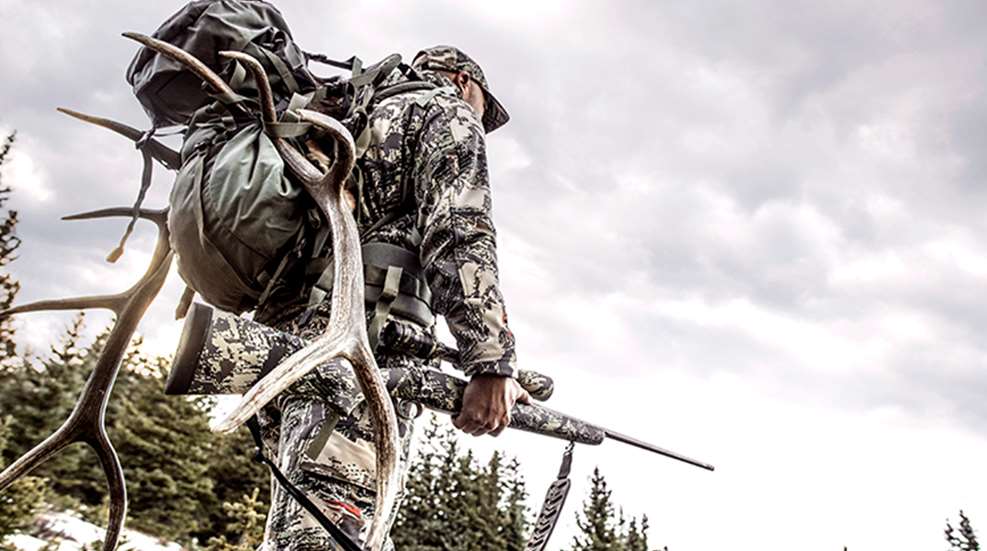
Shuffling wearily into camp, I leaned backward against a Ponderosa pine and eased into a squat until the elk antlers on my backpack pressed into the ground, pushing the pack’s weight off my shoulders.
Unsnapping the chest and waist straps, I wriggled free with a grunt as the pack slid off behind me. While resting on hands and knees, I swept my headlamp’s beam across my wristwatch: 2:53 a.m. More than 11 hours had passed since the bull elk hit the ground a mile below in the Kaibab National Forest. And nearly 21 hours had passed since I left camp the day before. But now my cot and pillow beckoned from inside the tent, and I obeyed.
Four hours later, refueled and re-energized, I hiked back down to the kill site to finish boning out the bull’s quarters and start hauling the meat to camp with my Mystery Ranch Pintler and Eberlestock Just One backpacks. I knew this descent into the canyon would be the day’s easiest hike, but I wasn’t dreading the work ahead. I was actually excited, and still reveling in my success the day before.
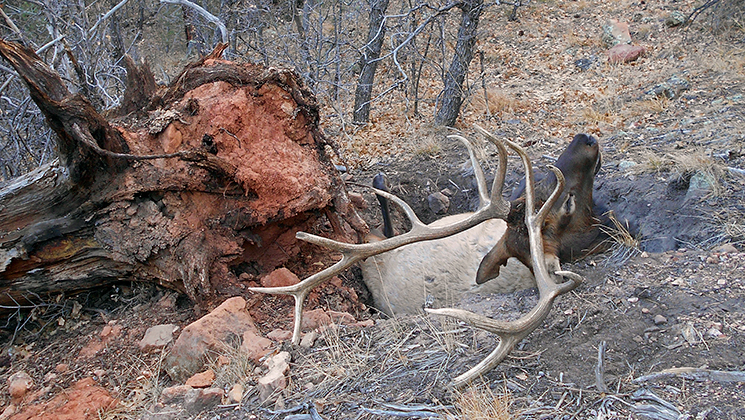
Reliving the Kill
The wide 5x6 bull had stepped into a crease between thick junipers around 3:30 p.m. on opening day of Arizona’s late rifle season, lowered its head and grazed like a Hereford on yellowed grass on the opposite slope. When it took another step and looked around, its antlers whacked juniper branches overhead.
As the bull walked uphill a few yards and quartered away, I snugged the .30-06 into my shoulder, steadied the scope’s crosshair behind its shoulder, and fired. I bolted another copper-bullet round into the chamber while absorbing the recoil but saw seconds later that it wasn’t needed. The bull was crumpling where it had stood 280 yards away, and then it convulsed before relaxing limply into death.
Just as I flicked on the Model 70’s safety, the bull’s body slid from its deathbed and skidded downhill 10 yards before disappearing like flotsam into a whirlpool, its hoofs and legs jutting skyward a split-second before vanishing, too. Puzzled, I raised my binocular and studied the spot, but all I could see was the bull’s upturned head, its nose pointing skyward.
After stuffing gear and outer clothing into my pack, I descended into the canyon, crossed its narrow valley and climbed 50 yards toward a dark, gnarly juniper that landmarked my bull. I spotted its head, still oddly upturned, as if someone had stiff-armed its chin backward. Even odder, I couldn’t see its body, even with a clear view from 30 yards.
A few steps later, the mystery ended. The bull had plopped into a tree throw—the gaping pit root systems leave behind when trees topple with a truck-full of soil stuck between their toes.
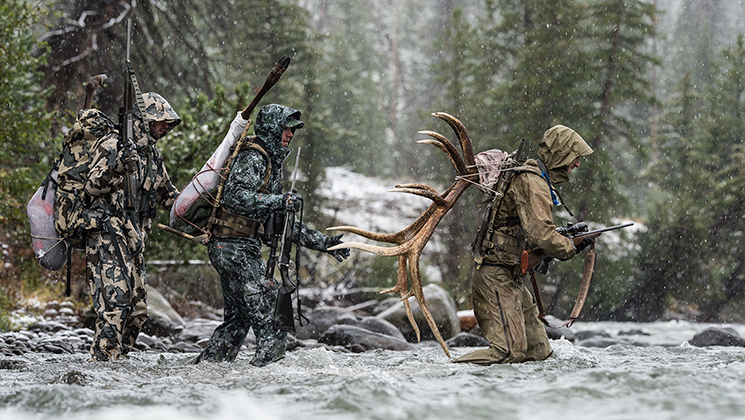
A Long Night Awaits
Whew. I was in for a long night. Bull elk average 650 to 700 pounds on the hoof, and I lacked a hoist or come-along to winch it from the 3-foot pit. Plus, its back was wedged beneath one corner of the hole, and its heavy hindquarters packed the lowest corner.
And I was hunting solo. Just for kicks, I squatted beneath a hindquarter, put my shoulder into it and tried standing. I hoped I could budge the body enough to roll it onto its back or flip it over.
Pfft! Forget it. Enough screwing around. I took off my pack, took some photos, and pulled out my knives, sharpener and field-processing gear. Then I strapped on the headlamp and got to work.
The hardest task was removing the bull’s hindquarters, which were pinned low in the pit beneath its paunch. To reach them I had to gut the bull, rather than use the gutless field-dressing method. But to gut it, I had to create an opening amidships. I couldn’t remove the entrails the usual way—from beneath the stomach or between its rear legs—given their weight, floppy nature and the pit’s depth. The bull’s chest, however, was nearly level with the pit’s upper lip, so I removed its left rib cage and pulled everything through there.
After that, I doggedly filleted muscle from bone and sinew, mining the meat piece by piece from the pit. Few slabs came out by their usual route. Eventually I removed the left forequarter and enough bulk from both hindquarters to roll the bull over to reach its backstraps and tenderloins. Later still I extracted the heart, neck meat, opposite forequarter and remaining ribs before stashing everything up the canyon a ways. After topping the meat pile with fallen branches and sweaty clothes, I caped out the bull’s head, sawed off its skull-plate, and lashed down hide, heart and antlers for the trip back to camp.
After returning at dawn, I finished boning the quarters, and sealed the chilled meat into 2.5-gallon plastic bags. I worked till dark packing meat from the canyon, caching it overnight atop the rim about a third-mile behind camp. I finished the chore at dawn with my game cart.
Hell of a Place to Die
I’ve hauled elk farther, but never before been so challenged breaking down an animal. Even so, friends and Facebook acquaintances soon one-upped me, sharing tales and photos of elk dying in hell-holes the animals surely chose out of spite.
The posts and emails basically said: “You think that’s bad? Well, look at this!” Their videos and horror photos showed elk in every possible dire strait: elk lashed to steep mountainsides to keep them from sliding farther; elk sprawled precariously atop shale slides; elk wedged 2 fathoms down between gigantic boulders; elk shoehorned into crevices at the feet of cliffs; elk jammed beneath fallen trees and snow-laden branches in brush-choked creek bottoms.
Fair enough. Elk extractions bring out the challenge-seeker in all of us. But those who do such chores regularly become so skilled and efficient that they consider their feats routine labor, not heroic tests of fortitude. Among those seasoned pros is Remi Warren, 33, owner of Montana OutWest Outfitters. Since his youth in Nevada, Warren has broken ribs, strained joints and compressed vertebrae packing out more than a thousand big-game animals from Alaska to New Zealand and Hawaii to Montana as a year-round guide and hunter.
Warren doesn’t pack heavy winches, hoists or pulleys to handle every possible situation he or his clients encounter. Give him a sharp knife and some sections of 550 paracord or 1,200-pound “mule tape,” and he’ll break down any elk, deer, bear, moose or mountain goat he’s sworn to extract.
Depending on the hunt, Warren carries a Stone Glacier pack that can carry an elk quarter between its bag and internal frame, or an Outdoorsman Long Range pack with an external frame. Either way, he insists on packs that can carry a load of meat, and/or cape and antlers on the first trip out.
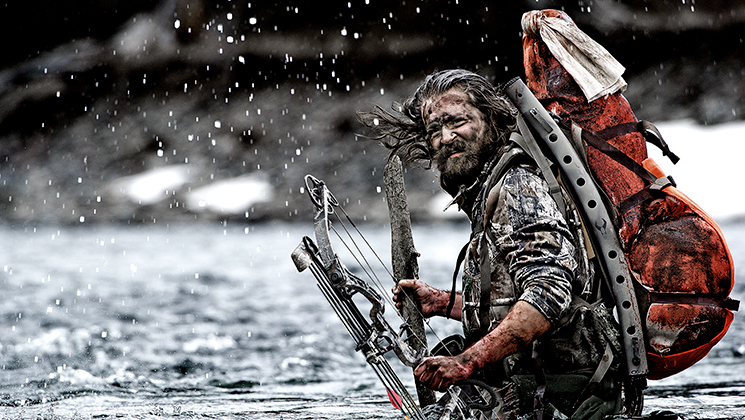
Warren’s Worst
When asked about his toughest extraction from a kill site, Warren can’t choose just one, given the varying terrain, weather and sheer numbers. All, however, involve elk. Maybe it was the bull that died late in the day in a Godforsaken hole beneath a snow-shrouded deadfall. It was midnight by the time he and his partner got it cut up, and then they climbed 3,000 forbidding feet to get back out.
Or maybe it was that time he guided some hunters through steep terrain whipped by high winds and raging slop. They ended up killing three bulls that day, but backpacking them out “definitely sucked.”
Then again, maybe Warren’s most spiteful elk die on nearly vertical mountainsides, forcing him to lash them to nearby trees to keep them from skittering into the abyss. But if Warren must generalize, the worst elk die beneath big deadfalls, with wet, clinging snow hiding briars and thorns in brush and low-drooping branches.
“We’ve cut elk apart in creek bottoms where you can’t avoid the water, and in deadfalls so thick it’s like working inside a jungle gym,” Warren said. “You have to climb over or slide under broken branches to reach the elk, and then you still can’t really get at them to work. That’s really hard. Every move is a challenge.”
No situation is impossible, however. He always figures things out. When elk die in holes, beneath deadfalls or in other messy, difficult locations, he removes the quarters with the hide on to save time and keep the meat clean. He then carries the quarters to cleaner sites for hanging and/or boning. Why hang meat? For one, stout hanging branches are usually more convenient and common than clean surfaces for piling meat.
Return Upright
The objective, of course, is to reach your tent or truck sore and tired, but injury-free. The alternatives are far worse. “Years ago I was going down a hill with a whole deer in my pack; about 120 pounds of meat, cape and head,” Warren said. “I slipped and started rolling. I popped three ribs off my vertebrae. I didn’t know if I could make the final mile, but I tightened everything down and made it to my truck. That was horrible; very painful. I really swelled up when I took my pack off. I was young then. If that happened today I’d probably have to leave the pack and crawl home.”
Whether you're young or old, don’t rush things. Try to savor the experience. No matter when you arrive, it’s better to be upright than broken. Once the euphoria of a successful hunt returns, your strength will surely follow.
Expert Tips for Extracting Elk
• Use the gutless method (see below). When it comes to field-dressing elk, outfitter Remi Warren prefers this method for several reasons. To start, it keeps the tenderloins clean. Once he removes the hindquarters and backstraps, he runs his knife up where the hip starts, cuts in to feel and peel the loins from beneath the spine and then tugs them out through an opening cut through the ribs.
• Keep front quarters large. When removing the front quarters, Warren keeps them attached to as much surrounding meat as possible from atop the ribs and shoulders, and up the neck to the head. “That makes each front quarter almost the same weight as a hindquarter, and makes it easier to hang everything,” he said.
• Prep the carcass for bears. Before he leaves the carcass for bears and other scavengers, Warren removes the tongue, fillets out the rib meat and cuts through the left side’s lower ribs to snag the heart. He moves all meat far from the carcass. Another advantage of going gutless is that bears stay preoccupied longer by the spine, rib cage and internal organs at the kill site.
• Load it right. Position elk quarters heavy side down in the pack or on the frame. When placing bagged meat into your backpack, keep the weight centered a bit higher than the pack-bag’s center on external-frame packs, and centered closely to your body on internal-frame packs. “There’s weight and there’s felt-weight,” Warren says. “Gravity makes a poorly packed load feel heavier than it is. Pack the weight more vertically on an external-frame pack as it’s standing up, and more horizontally on an internal-frame pack as it’s lying on the ground.”
• Tighten your load. When packing out meat, Warren cautions against “flappy pack syndrome. “If you’re carrying lots of weight and it’s shifting around, it’s dangerous,” he notes. “Everything must be tightly secured or you’ll tire even faster.”
• Don’t carry too much. No matter your experience level, be cautious. Don’t carry too much. When pressed for time, Warren has carried his body weight, 170 pounds, but he prefers smaller loads. “I’d say a normal person would carry a hindquarter in one trip; two front quarters in another trip; the other hindquarter in another trip; and then the head, loose meat and whatever you can fit on another trip,” Warren says. “That’s reasonable.”
• Pack out only what you need. If you plan to do a shoulder mount, Warren recommends learning to cape the animal so you can leave the head behind after removing the antlers. Caping takes time, but it’s not difficult, especially on elk, and can reduce pack weight significantly. If you prefer European mounts, remove the lower jaw and ditch it.
• Use a walking stick. Before hiking off, find a stout walking stick, or a pair of them, for balance and extra contact points with the ground. “When you have lots of weight on your back, you really can’t control every step, especially if it’s slick,” Warren explains. “Walking sticks help your stabilization muscles last longer. Those muscles aren’t used very often under heavy strain. As they wear out, people fall and get hurt. It’s not so much their legs giving out. It’s more about those little-used muscles you don’t even know exist. You must keep your core straight, steady and balanced.”
The Two-Pack Method
You may have noticed I mentioned bringing two packs for packing out my Arizona bull's meat, hide and horns. While I can only carry one loaded pack at a time, having two slightly different size packs offers me a change of pace and the ability to “ferry” my load.
The smaller of those two packs—the Mystery Ranch Pintler—is my hunting pack, which holds essentials: survival kit, personal locator beacon, two knives, sharpening tool, etc. I seldom need that stuff once I’m packing meat, but I don’t like leaving it at the kill site or back at camp. The Pintler can also be quickly modified for carrying meat inside the main bag and beneath it (between the bag and pack frame).
I do the main meat packing with my bigger Eberlestock Just One pack. I usually “ferry” the meat out, going as far as I can go before taking a break or two with the Eberlestock, and then returning for the lighter load in the Pintler, which I then usually pack beyond the distance I toted the Eberlestock. That way, my essentials are never that far away should I need them.
Going Gutless
To save time and effort when packing out elk, try the gutless method to efficiently remove all meat, including the tenderloins.
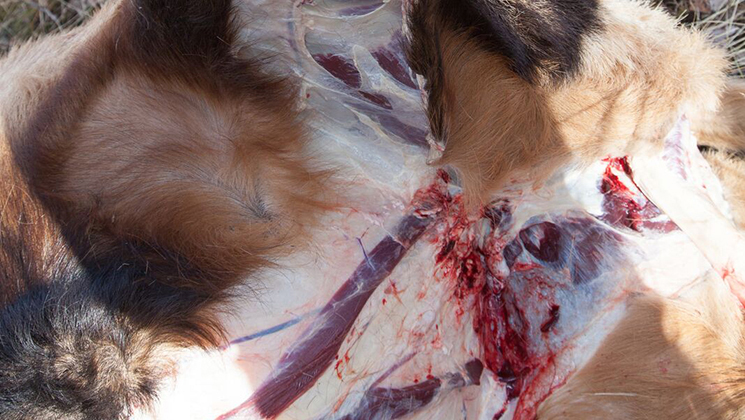
1. Lay out the elk full-length on either side, and cut the skin around its lower foreleg and hindleg, just above the knee. Using a gut-hook or gutting blade, zip open the skin on both legs, working upward to the lower body. Next, open the skin along the lower abdomen, joining the cuts from one leg to the other. After slicing the skin behind the skull (provided you don't need the cape), zip open the skin beneath the neck, working from beneath the jawbone to the foreleg’s cut.
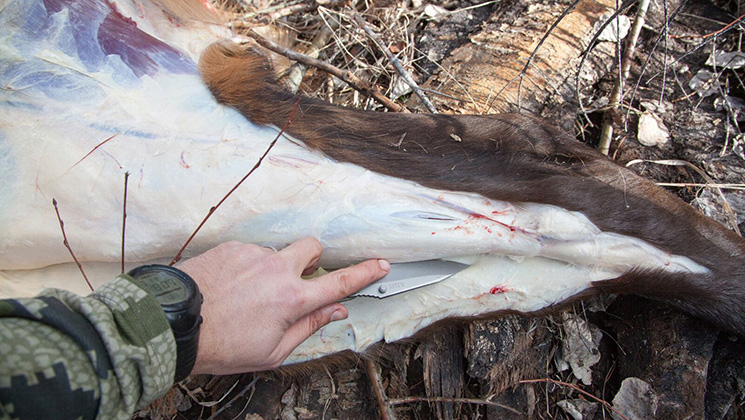
2. Skin the entire side to atop the elk’s spine, and stretch the hide neatly on the ground behind. If you keep the flesh side clean, you can use that surface as a work area for boning and bagging meat.
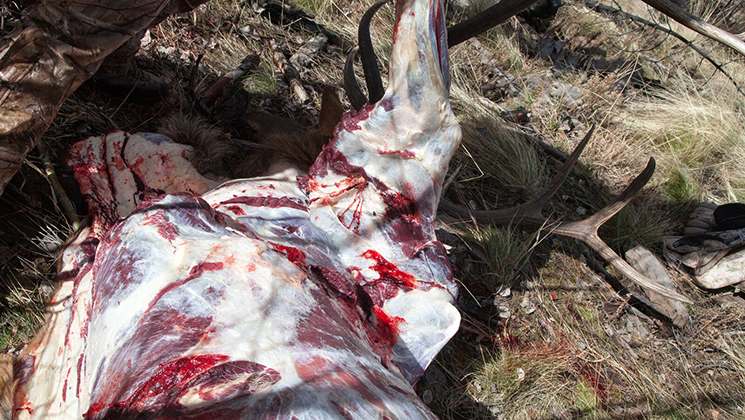
3. Remove the forequarter by slicing the connecting tissue/meat between the shoulder and ribcage. Lay the forequarter atop the hide (or other clean area), and bone out the muscle groups.
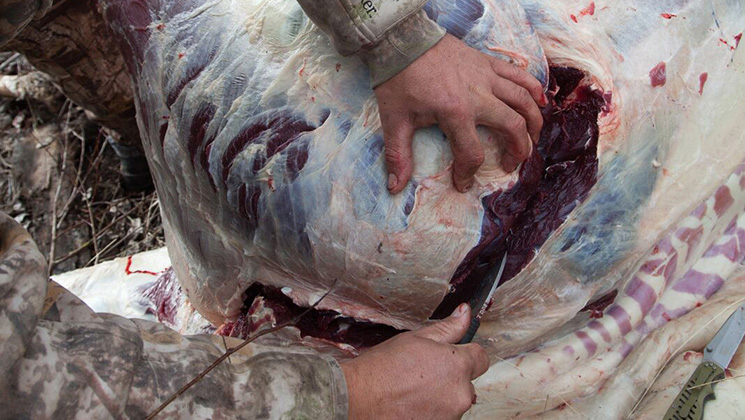
4. Remove the hindquarter by slicing beneath the spine at the upper pelvis, and make a deep, circular cut around its base. Lift the hindquarter, locate the hip socket, and then cut the connecting tendons between the ball and socket. Lay the hindquarter atop the hide and bone out the muscle groups. Leave a chunk of meat attached to the genitals for evidence of sex, if required.
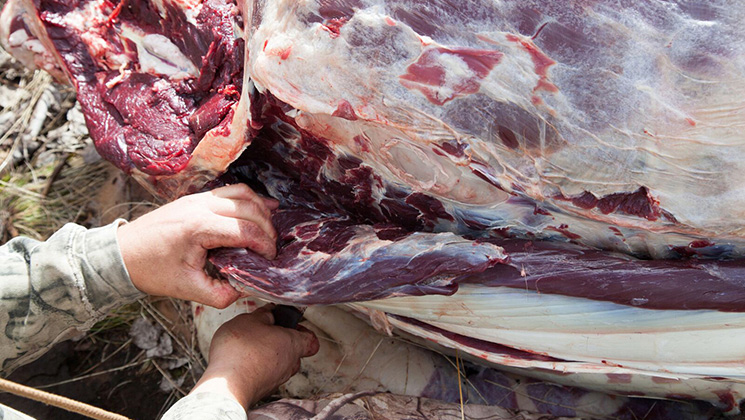
5. Fillet out the neck meat and backstrap on that side along the spine, and remove all other meat/trimmings. Bag all meat from that side and store it in a cool place. Now, flip the elk over and repeat the process.
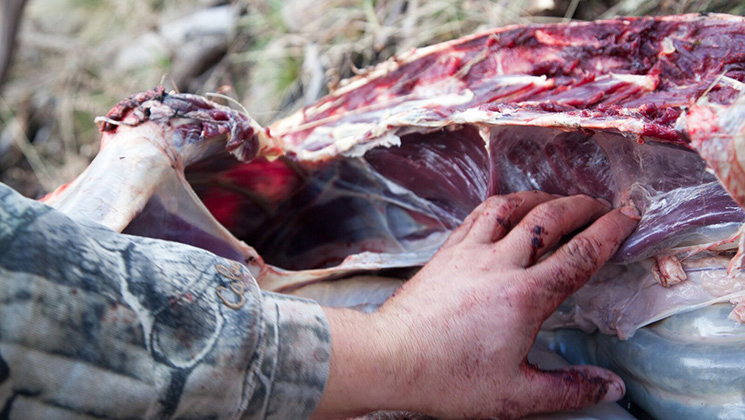
6. To remove the tenderloins, locate the final rib and cut carefully along the spine. You can remove the rib for extra working room, but it’s not necessary. Probe under the spine with your fingers and use a small knife, as necessary, to fillet and tug out the tenderloin as far forward and rearward as possible. Flip the body and repeat.
If you wish to keep the ribs intact, carefully cut into the chest cavity’s rear to locate the diaphragm, being careful not to puncture it. Work forward from there. Cut or saw out the rib cage along the spine and above the sternum, or simply fillet out the strips between each rib. Flip the body and repeat. Don’t forsake the heart. It makes a great meal, at camp or at home.




































